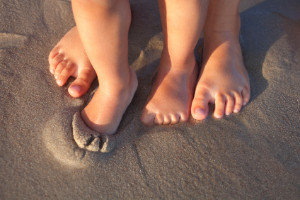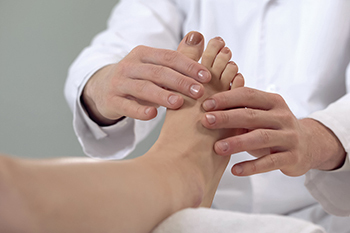Items filtered by date: October 2022
Common Congenital Foot Problems

The two most common foot problems in babies are metatarsus adductus and calcaneovalgus. Both of these conditions come from how the baby was positioned inside the womb. These foot issues usually improve without treatment or long-term side effects. Metatarsus adductus is when there is a curve in the middle of the baby’s foot. This occurs when the feet are folded inward. If the foot remains flexible, and it can be straightened out into a normal position, it will usually disappear by 6 to 12 months of age. Feet that are more stiff may be helped along with casting. Calcaneovalgus is when the foot is pushed up and out. It may be hard to push the newborn baby’s foot down all the way, but this can be improved over a couple of months. If you are concerned with your newborn’s feet, contact a chiropodist as soon as possible to find out if anything is amiss and needs to be treated.
If your child is experiencing foot or ankle pain, please consult with Chiropodist Stephanie Poupore from North Bay Foot & Ankle. Our clinician will assess your condition and provide you with quality foot and ankle treatment.
Common Causes of Foot Pain in Children
While children can experience many of the same foot problems as adults do, some foot problems may be more common during childhood.
Causes of foot pain in children can include:
Deformities that are present from birth, such as flat feet or clubfoot
Sever’s disease, which is an inflammation of the growth plate in the heel bone
Various sports injuries, such as sprains and fractures
Ingrown toenails
Athlete’s foot
Plantar warts
Prevention
It is important to look after the health of children’s feet in order to prevent future problems from arising. Keep your child’s feet clean and dry, trim their toenails regularly, ensure their shoes fit properly, and keep a watchful eye on any symptoms of foot pain, such as limping. If you notice any symptoms or if your child complains of foot pain, a chiropodist can help.
If you have any questions, please feel free to contact our office located in . We offer the newest diagnostic and treatment technologies for all your foot care needs.
Heel Pain in the Morning?
What Is a Tailor’s Bunion?

A tailor’s bunion is also called a bunionette. It is a bump on the 5th metatarsal bone at the base of the baby toe. Tailor’s bunions are not as common as bunions on the big toe, but they are similar in symptoms and causes. These small bunions were named because centuries ago tailors used to sit cross-legged all day, with the outside edge of their feet rubbing against the ground. The constant rubbing led to a painful bump at the base of the little toe. A tailor’s bunion may be from an inherited faulty mechanical foot structure. The 5th metatarsal bone starts to protrude outward while the baby toe moves inward. Sometimes a bunionette is a bony spur or outgrowth of bone on the side of the 5th metatarsal head. This condition is aggravated when shoes have narrow toe boxes and constantly rub against the tailor’s bunion. Symptoms include redness, swelling, and pain at the site of the bump. If you have a bump on your baby toe, consult with a chiropodist who can determine its cause and provide treatment options.
Bunions progressively worsen over time and may cause walking in your shoes to become difficult. To learn more about bunions, please consult with Chiropodist Stephanie Poupore from North Bay Foot & Ankle. Our clinician will assess your condition and provide you with quality foot and ankle treatment.
What Are Bunions?
A bunion is a bony bump that protrudes from the base of the big toe. Bunions are caused due to a misalignment of the first metatarsal. The characteristic bump of a bunion forms when the metatarsal shifts outwards from its proper position. Bunions develop slowly over time and progressively worsen without treatment. The skin over the bunion may develop calluses due to the friction from shoes. Eventually, a bunion can make walking uncomfortable or even painful. Bunions are one of the most common foot deformities and are especially common in women and older adults.
Symptoms
A bunion appears as a bulging bump on the outside of the base of the big toe.
The bunion may also:
Be swollen, red, or sore
Develop corns or calluses over it
Cause pain
Limit the big toe’s range of motion
Treatment
There are several different treatments available for bunions. Conservative treatment options include wearing shoes with a wider toe box, cushioning the bunion with a specialized pad, wearing shoe inserts, icing the bunion if it becomes inflamed, and taking medications to relieve pain. In more severe cases, more invasive procedures may be done. This may involve removing the swollen tissue around the bunion, straightening the big toe, realigning the bones at the front of the foot, or a combination of these procedures.
If you have any questions, please feel free to contact our office located in . We offer the newest diagnostic and treatment technologies for all your foot care needs
Causes and Treatments of Broken Toes

A broken toe is a common foot injury that generally causes discomfort and pain. Many people choose to walk on a broken toe even though it needs adequate rest to heal properly. A broken toe can occur from dropping a heavy object on it, or by jamming into a piece of furniture. Patients often know they have broken a toe because of noticeable symptoms that rapidly appear. These can include bruising, and swelling, and in severe fractures, the toe may look displaced. The buddy taping method can be successful if the break is mild. Buddy taping is accomplished by wrapping the affected toe to the toe next to it, which can provide stability as the healing process begins. The average time for a broken toe to completely heal is approximately six weeks and it is strongly advised to keep the weight off as much as possible. If you have broken your toe, please confer with a chiropodist who can diagnose and treat this foot condition.
A broken toe typically occurs following either a sudden, traumatic injury, like dropping a heavy piece of furniture on the toe. The impact causes the bone to fracture and produces a variety of painful symptoms. If you suspect that you’ve broken your toe, please consult with Chiropodist Stephanie Poupore from North Bay Foot & Ankle. Our clinician can help you maintain the health of your lower limbs and your mobility.
Symptoms
Throbbing pain
Swelling
Bruising
Cracking sound at the time of injury
Difficulty bearing weight on the toe
Difficulty walking
Toe resting at an unnatural angle
Diagnosis
Your chiropodist can diagnose a broken toe through physical examination and imaging studies, such as X-rays.
Treatment
The main goals of treatment are to ensure that the bone heals properly, as a toe fracture that doesn’t heal properly can lead to osteoarthritis. You will typically need to rest the affected toe. You may be prescribed a splint to immobilize the toe while it heals. Icing the affected toe and taking over-the-counter medications can help reduce pain. In cases of severe fractures, surgery may be necessary to reset the broken bones and make sure that they heal correctly.
If you have any questions, please feel free to contact our office located in . We offer the newest diagnostic and treatment technologies for all your foot care needs.
How Is Cuboid Syndrome Treated?

If you have pain on the outside of your foot it may be indicative of a foot condition known as cuboid syndrome. This can happen as a result of gradual overuse or from a sudden injury. The pain may worsen when the foot is moved from side to side and it may become inflamed from standing and walking. Additionally, symptoms like swelling may affect one's gait. Mild relief may be felt when specific foot stretches are performed as well as the cuboid bone being manipulated into its normal place. Cuboid syndrome may be confused with an ankle sprain due to similar symptoms. With successful manipulation and the cuboid bone being back in place, wearing custom-made orthotics may be an effective choice for a complete recovery. If you have pain in this part of your foot, please consult with a chiropodist who can properly diagnose and treat this foot condition.
Cuboid syndrome, also known as cuboid subluxation, occurs when the joint and ligaments surrounding the cuboid bone in the foot become injured. If you think that you may have cuboid syndrome, please consult with Chiropodist Stephanie Poupore from North Bay Foot & Ankle. Our clinician will assess your condition and provide you with quality foot and ankle treatment.
Causes
The cuboid bone is one of the seven tarsal bones located in the foot. Cuboid syndrome develops when the cuboid bone moves down and out of alignment with the other bone (calcaneus bone) in the joint of the foot. Cuboid syndrome can be the result of a sudden injury like an ankle sprain, or it may develop slowly over time from repetitive tension through the bone and surrounding structures.
Symptoms
The most common symptom of cuboid syndrome is pain on the outside of the foot which may worsen with activity.
Other possible symptoms include:
Difficulty bearing weight on the affected foot
Swelling
Sensitivity on the bottom of the foot
Reduced range of motion
Diagnosis
A chiropodist can diagnose cuboid syndrome based on your medical history and a physical examination of the foot. Imaging studies, such as X-rays or MRIs, often fail to show the dislocated cuboid.
Treatment
Treatment often includes resting, icing, compressing and elevating the affected foot, taping, wearing orthotic inserts, and taking anti-inflammatory medications to reduce pain. The chiropodist may also be able to manipulate the dislocated bone back into alignment.
If you have any questions, please feel free to contact our office located in . We offer the newest diagnostic and treatment technologies for all your foot care needs.

